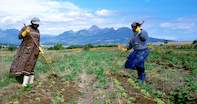Fertilizers are materials that are either organic and from natural matter that was once living or a synthetic chemical makeup of macro and micro nutrients. These are applied in granular form or as liquids to the soil.

The nutrients can also be sprayed on the leaves of plants to stimulate growth and supplement nutrients in the plant. The three main nutrients that are used by a plant are Nitrogen (N), Phosphorous (P) and Potassium (K).
When deciding what fertilizer to use these are the main macronutrients that will be identified in the results of your soil sample analysis.
The fertilizers are formulated into different mixtures of these three macronutrients and are identified by the three numbers marked on the bags of fertilizer denoting the NPK makeup of the fertilizer and the ratio of their value in the mixture. For example: 2:3:4 (27) or 1:0:1 (36) will be the NPK value.
Description of NPK
The NPK markings on the fertilizer describe the percentages of each of these nutrients as a ratio proportional to each other. The number after the ratios in brackets (e.g. 27) is the percentage of the total mixture that represents only the three main macro nutrients, namely N, P and K.
Therefore, in a 100 kg bag of 2:3:4 (27):
The (27) means that 27% of the bag or 27 kilograms represents the total pure N, P and K.
The ratio is made up of 9 parts by adding 2+3+4 and if you divide 9 into the 27 then each part of the ratio represents 3.
Therefore:
The 2 multiplied by 3 is 6% Nitrogen (N) or 6 kilograms.
The 3 is therefore 9% Phosphorous (P) or 9 kilograms.
The 4 is therefore 12% Potassium (K) or 12 kilograms.
The other 73 kilograms of the 100 kilograms of fertilizer is made up of filler elements that make it easier to handle the fertilizer, carrier elements that make the N, P and K more accessible to the plant roots in the soil and other trace elements like Copper, Zinc, Boron, Manganese and Magnesium that can be used by the plant.